 |
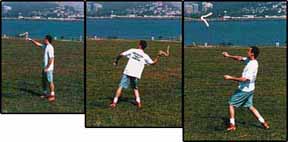 |
 |
 |
| Right-handers must use right-handed boomerangs. | |
| Left-handers must use left-handed boomerangs. | 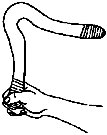 |
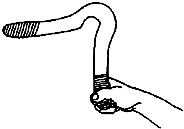 |
| Right-handed Dingle Arm Grip |
Right-handed LIft Arm Grip |
| You must always grip the boomerang so that the curved, painted side is toward you. The flat, unpainted side should face away from you. (In flight, the curved side is the top and the flat side is the bottom.) You can grip the boomerang by either the dingle arm or the lift arm. | 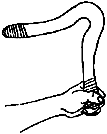 |
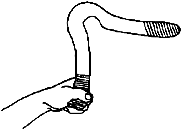 |
| Left-handed Dingle Arm Grip |
Left-handed Lift Arm Grip |
Return to TOP
| Chose a grip that is comfortable for you. |
 |
| Pinch Grip |
| Make your hand into a hitchhiking sign, and then pinch the boomerang tightly between your thumb and first finger. |
 |
| Pencil Grip |
| Support the boomerang with your thumb, first finger, and middle finger as shown. The first finger hooks around the edge of the boomerang. |
Return to TOP
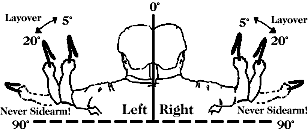
|
| Boomerangs are thrown overhand, not sidearm! The boomerang
should be nearly vertical (perpendicular to the ground) when it
is released. The layover from vertical should be no more than
5-20°. Upon release, the boomerang should cartwheel forward, end over end,
in a nearly vertical plane.
It is extremely important to avoid using too much layover. If the boomerang is thrown with too much layover and released too horizontally, it will spin like a frisbee, suddenly climb high into the air, and then dive straight into the ground. Boomerangs may break when thrown in this way. |
Return to TOP
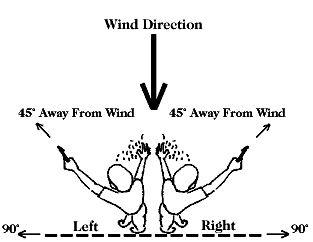
|
| Drop a pinch of grass into the air to see which way the wind is blowing. Face directly into the wind. Then turn to the right about 45° away from the wind if you are right-handed, or turn to the left about 45° if you are left-handed. |
Return to TOP
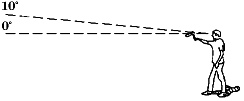
|
| Pick a point (such as a tree or rooftop) a little higher than the horizon. Keep your eye on that point and throw at it. |
Return to TOP

|
| 1. Aim a little above the horizon.
2. Cock your arm back over your shoulder, with your wrist bent backwards. Follow through with a smooth body motion and a strong snap of the wrist. The snap will create spin, and spin is more important than power. Grip tightly throughout the throw and release. The boomerang will pull itself out of your grip. 3. Be sure that the boomerang is released in a nearly vertical plane. Do not throw horizontally (sidearm). |
Return to TOP
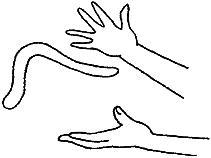
|
| After you are familiar with the flight pattern of your boomerang, you can attempt catching. However, never try to catch plummeting boomerangs, or boomerangs that are returning rapidly, or higher than chest level. The trick in catching is to make a "boomerang sandwich." Hold one hand above and one below, with palms parallel to the boomerang. As the boomerang floats between them, slap your hands together. |
Return to TOP

| ||
| 1. Hold 'rang nearly vertical with flat unpainted side away from you. Face into the wind. Then turn about 45° to the right if you are right-handed, or about 45° to the left if you are left-handed. | 2. Cock arm back, with wrist bent backwards. Aim at a point just above the horizon. | 3. Throw with a smooth body motion and a snap of the wrist. Release the boomerang in a nearly vertical plane so that it cartwheels forward. |
Return to TOP

| ||
|
In windy conditions (over 5 MPH), boomerangs tend to fly over your
head and past you. There are four things that you can do to prevent
this. The best approach is to attach flaps to either the curved or
flat side of your boomerang, near the elbow. The further they are
from the elbow, the more effect the flaps will have. Experiment
for the best placement. The heavier the wind, the more flaps you
should use.
Second, try throwing softer. Third, you can throw with less layover. Fourth, throw higher (with minimal layover). The heavier the wind, the higher you should throw. Usually a combination of two or more of these strategies works best. The Bellen Wind Dancer is an excellent boomerang designed to perform in moderate to heavy winds. No serious thrower should be without one. |
||
Return to TOP
| After you have mastered the two-handed catch, you can try to catch one-handed, under-the-leg, hand-to-foot, and behind-the-back. Then use your imagination and make up your own trick catches! Rad fun! | ||
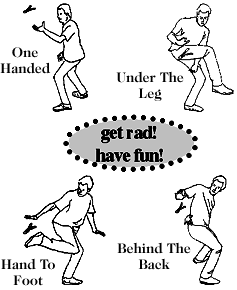
| ||
Return to TOP
Gel Boomerangs™
Copyright© 1995 - 2005.
All rights reserved.
Last updated April 14, 2005.
Home
![]()